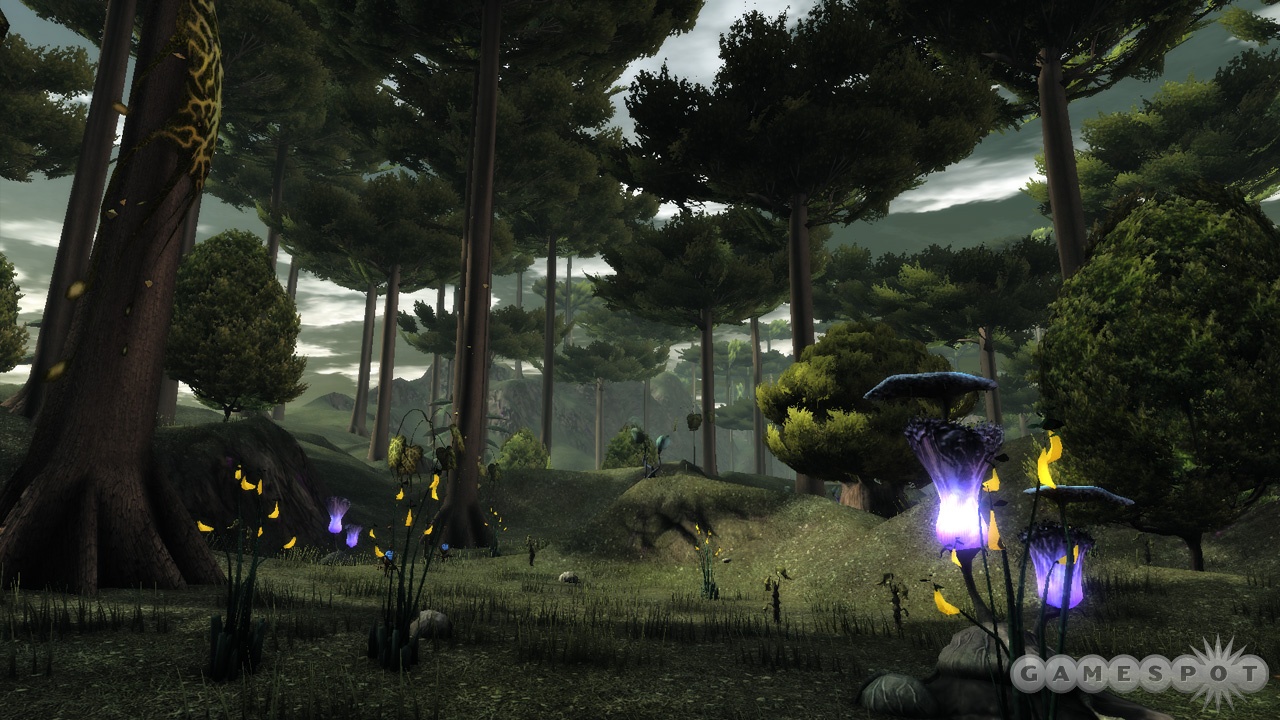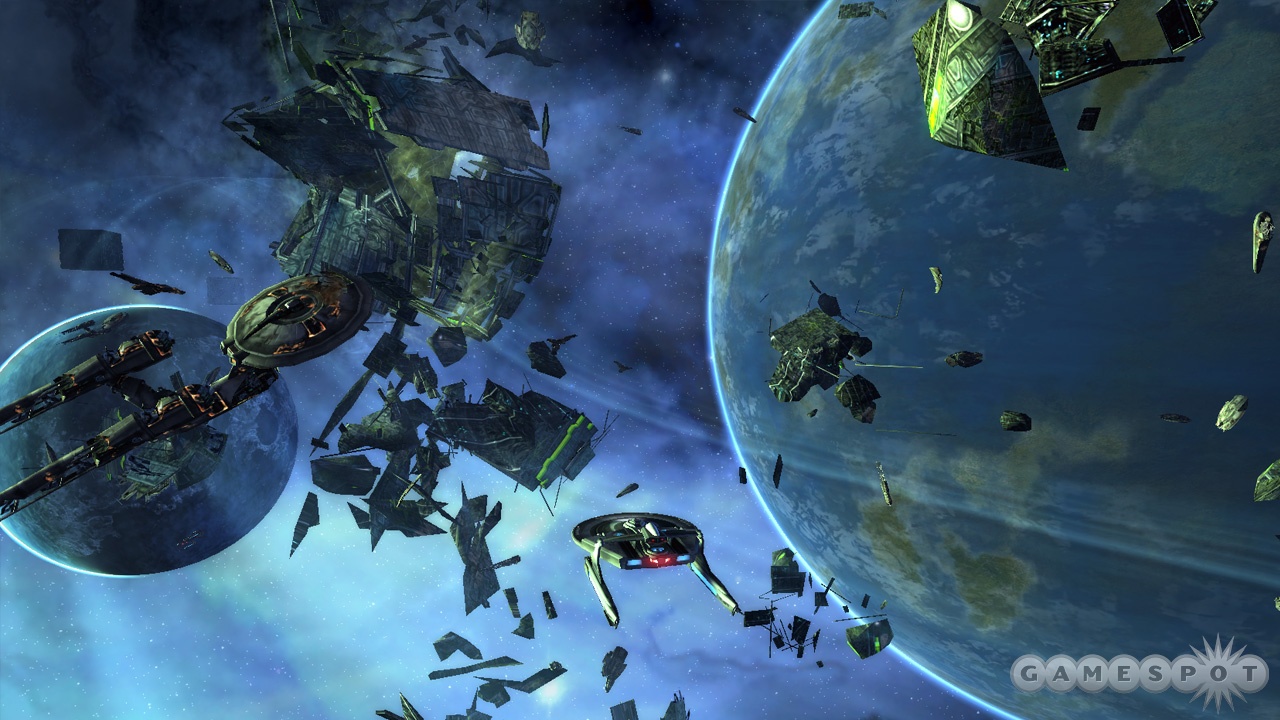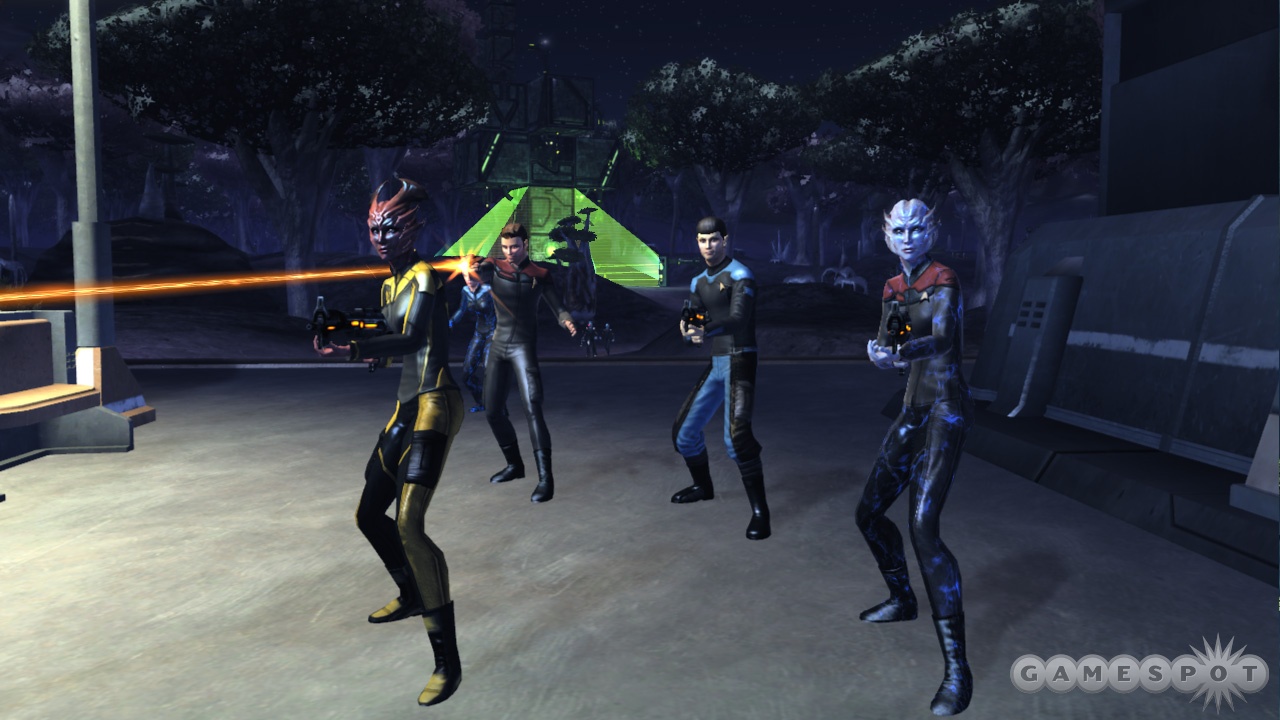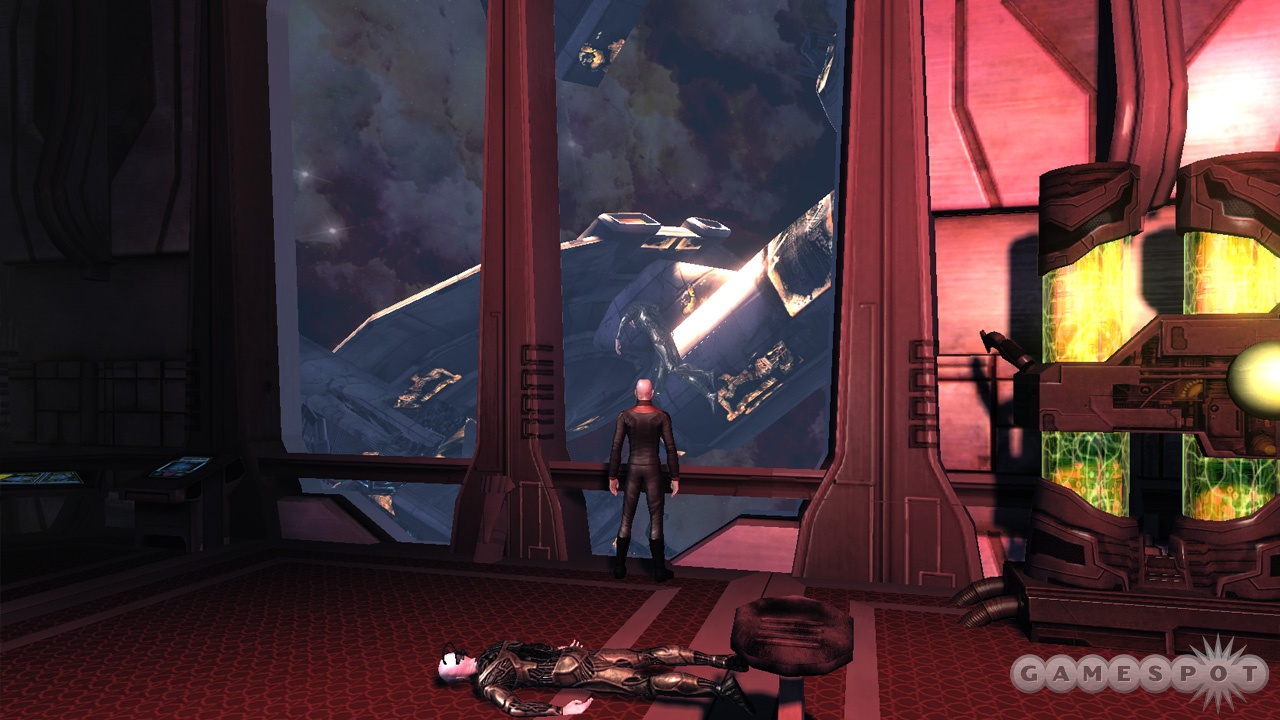Star Trek Online Exclusive Hands-On - Starflight and Away Team Gameplay
We get our hands on both the space and ground gameplay of this online game based on the classic TV and motion picture series. Here's our exclusive report.
Space: the final frontier. Seeking out new life and new civilizations. Boldly beaming down to the face of an alien planet while not being the one wearing a red shirt. These are the voyages you'll undertake in Star Trek Online, the Star Trek-themed massively multiplayer online game from Champions Online developer Cryptic Studios and publisher Atari. If you've been following the game, you'll know that it takes place decades after the events in the Star Trek: Nemesis motion picture, so sadly, most of your favorite characters probably won't be returning. On the bright side, the peace treaty between the Federation and the Klingons is breaking down, which means there will be intergalactic war and the chance to zap your enemies into oblivion--both in space and on foot in away team gameplay. We gave both these play modes a shot and have much to report. Note: Please be advised that this story may contain minor spoilers.

Much of the demonstration we played through seemed similar to the content we recently saw at the GamesCom event in Cologne, though this time around, we were actually at the helm and able to play for ourselves. The space mission we played was the same one: an escort mission for a Vulcan ambassador to a Vulcan monastery homeworld. It actually takes place very early in the game right after the tutorial area, and as a result, we were equipped with the starting cruiser-class ship. The game will have three basic classes of ship (escort, cruiser, and science), and while each vessel class will have numerous interchangeable parts that can be swapped in or out to create a distinctive-looking ship, you'll generally be able to tell, at a glance, which class of ship you've got.
We joined a party with several members of the Cryptic team to head out on the mission. The space-faring interface, while perhaps not complete yet, has been tweaked since the last time we saw it, though it seems to have a lot of the same functionality we've previously covered. Both on-the-ground and space combat are "fully RPG-based," in the words of lead producer Craig Zinkievich. That is, while combat takes place in real time, it's not based on reflexes or arcade-style aiming, but rather, on traditional massively multiplayer role-playing-game-style mechanics of targeting enemies and triggering attack skills. These attacks will hit, miss, and deal damage based on your character's level and the level of your character's equipment (in this case, your hand-phasers and your starship).
Space exploration and combat will use controls similar to what you've seen in other massively multiplayer games. You can use the W, A, S, D keys to turn your ship from side to side or pitch its nose up or down; you use the Q and E keys to add to or reduce your throttle speed. (Be advised that the early version of the game we played and its interface are subject to change.) The throttle interface also has two additional buttons that can be clicked: a "reverse" button to throw your ship in reverse and a "full impulse" command that kicks your ship into its highest speed setting at the cost of reduced energy to your ship's other systems (namely your shields and weapons).

Shields are currently set on four points of your ship: fore, aft, port, and starboard (or front, back, right, and left, if you prefer). They are modeled as colored transparencies that hover on all sides of your ship, starting off light blue but eventually turning yellow, then red, and then disappearing entirely once they take enough damage (or, at least until you can reroute enough power to them). The current ship interface has a "paper-doll"-like model of your ship with its four shields at the bottom of the screen, and if you notice one or more of your ship's shields flagging, you can click on that shield to reroute your ship's power to replenish the shield.
You can actually choose to route your powers to engines, shields, or weapons with a series of sliders (that also have preset levels optimized for defense, attacking maneuvers, and so on), and the weapons mounted in the weapon bays of your ship are currently hotkeyed to the number keys. These are generally photon torpedo bays, which have a specific cooldown time associated with them. The larger your ship, the more slots you can have available to install torpedoes or extra banks of phasers--the signature laserlike energy weapons of Star Trek that can also currently be activated by pressing the space bar. Torpedos are powerful but best used against the bare hulls of enemy ships whose shields you've been able to chew away to nothing.
In addition to these abilities, you'll have other abilities unique to your character, which you can unlock either through your character's advancement as a military officer in one of three character classes (a combat-oriented tactical officer; a tech-and-gadgets-focused engineering officer; or a medical-and-research-oriented science officer) or by way of your team of bridge officers who can also be similarly specialized. Your character's abilities include such things as evasive maneuvers, which temporarily enhance your ship's turning speed, and "brace for impact," which is a last line of defense against bursts of heavy damage caused by explosions of spacecraft. Your crew, on the other hand, can provide such handy science officer abilities as a tractor beam to drag enemy ships into range or tachyon beams to drop enemy shields. There are also engineering abilities, such as spot repairs of your hull, emergency power to shields, or even the tactical officer's photon torpedo salvo, which lets you launch three rounds simultaneously rather than just the one--devastating to an enemy ship with no shields.

Our mission escorting the Vulcan ambassador went more or less as described in our GamesCom coverage, but it escalated when Klingons intercepted our convoy and demanded the surrender of the ambassador by claiming he was an evil shape-shifter. Yeah, right. And miss the chance to take this cruiser-class ship into battle? Soon, we were engaged in ship-to-ship combat with the Klingons, following the lead of the Cryptic developers to focus in on either the enemy ships that were the most dangerous targets or the easiest prey. Cruiser-class ships aren't the fastest in the game, so we found that jousting didn't really work as well as simply keeping our noses pointed at a specific shield area on an enemy ship and unloading phaser fire until the enemy ship's shields dropped and we could launch a torpedo salvo. We had a few cases of near-disaster as we got too close to an enemy flagship just as it was exploding. But fortunately, we managed to stay clear of the major blasts and from the damaging, bright-blue "warp plasma" that will sometimes hover in the wake of an exploding ship.
We completed this particular mission and skipped ahead to a different one; a distress call in a different star system, which we jumped to by warping our ship out to the zoomed-out star map view that essentially acts as an "overworld" in the game. The star map view lets you quickly transit from one system to the next and will even have you encountering enemies that appear in certain sectors from time to time. If you care to, you can pursue them by flying into their vicinity, which will drop you back into a close-quarters ship battle. We avoided hostile encounters and headed toward the space station, which, unfortunately, was being attacked by enemy ships we dispatched. Once we eliminated the enemies, we then set about the task of repairing the floating components of the station's power grid by flying near the components and pressing the "F" key to interact (just like in Champions Online). But once we finished this task, we were hailed by the commanding officer of the station and asked to beam down to help.

We beamed down with our group of four other Cryptic developers as an away team, which generally consists of five characters (your character, any other human teammates who may be joining you, and your computer-controlled bridge officers filling in any empty slots). Bridge officers, again, provide useful abilities when used to staff up your ship's bridge, but they really come into their own when you bring them planetside. Zinkievich suggests that bridge officers will be "like massively multiplayer pets, but to the next level" because these characters can be fully customized for their appearances, skills, and weapon loadouts, as well as gain experience levels over time.
The idea is that as you advance through the military ranks, you'll eventually amass an active roster of bridge officers that's too big to crew your current ship and will be able to scroll through dozens of different, interesting characters with varying abilities. You'll then be able to choose the handful or so that make the most sense for the mission you're currently on and eventually come to favor a regular shift of officers that best fits your playing style. Fortunately, despite the fact that your bridge officers can become incapacitated in ground missions, they can never be permanently killed.
As we've mentioned previously, each character on foot carries two weapon loadouts (though one of these loadouts can simply be barehanded melee, like our character). On foot, you can carry two-handed phaser rifles or the classic one-handed Star Trek hand phaser, which, yes, can be set for stun. All on-foot weapons have three primary attack modes: a standard attack mode, a secondary mode (such as a sniper shot on a phaser rifle), and a melee attack, which, depending on the skill and strength of your characters relative to their enemies, may send your foes sprawling. In addition, all members of an away team have personal energy shields that will absorb incoming damage first. All characters will actually have two different status meters: a shield meter and a health meter. Like in the Halo games, if your shields take damage and you can duck away from combat briefly, your shields will regenerate back to full power.

We hacked our way through the damaged space station to repair damaged gas vents and ambush (and get ambushed by) small Klingon war parties roving the halls. Fortunately, in addition to our weapon loadouts, we had other miscellaneous abilities that can be derived from a "kit." These kits include various sets of peripheral gadgets that each of the three character classes can choose to bring with them. Our kit had a set of proximity mines that would blow up any foes foolish enough to come charging at us, though other kits include an engineering officer's shield generator (which generates enhanced protection for any friendlies nearby but may be destroyed by enemies and explode, damaging everyone in the blast radius).
The pace of the battles seemed reminiscent of City of Heroes and Champions Online. Rather than just standing still and repeatedly firing weapons from a distance, both we and our enemies did a good deal of dodging and weaving, looking to sneak in the odd melee attack whenever we got into range. On foot, enemies can also be briefly made vulnerable by focused fire or certain abilities, which puts a glowing icon over their heads. In this state, they're particularly susceptible to the effects of your weapon's secondary firing mode.
We finally cleared this mission only to head out on a new mission to investigate a missing set of medical supplies for a Vulcan colony. We later found that the shipments had been hijacked by the Gorn, which are a hostile race of lizardlike humanoids (William Shatner's Captain Kirk character wrestled one in the classic episode, Arena). After tearing up their space patrol with the help of the Cryptic team's superior gameplay skills, we beamed down to the planet to be immediately attacked by Gorn warriors and their pets. These pets were doglike reptiles called "attack saurs" that tended to go right for our engineering officer's deployed shield generators. After hacking our way through the assembled forces of the Gorn (and their surprising allies...the Klingons), we made our way to the end of the mission to find a package of supplies secured by Vulcan scouts.

It's been a long time coming, but Star Trek Online is truly starting to take shape as a game. After finally seeing and playing the on-foot component of the game for ourselves, we can say that the game looks and feels far more like a complete game experience; one in which you'll regularly switch between space exploration and combat and away team missions. We're also told that the game's beta will be opening soon. Hopefully, the game itself won't launch too much later.
Got a news tip or want to contact us directly? Email news@gamespot.com
Join the conversation